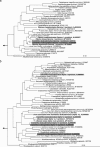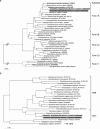Phylogeny of 16S rRNA, ribulose 1,5-bisphosphate carboxylase/oxygenase, and adenosine 5'-phosphosulfate reductase genes from gamma- and alphaproteobacterial symbionts in gutless marine worms (oligochaeta) from Bermuda and the Bahamas
- PMID: 16885306
- PMCID: PMC1538757
- DOI: 10.1128/AEM.02441-05
Phylogeny of 16S rRNA, ribulose 1,5-bisphosphate carboxylase/oxygenase, and adenosine 5'-phosphosulfate reductase genes from gamma- and alphaproteobacterial symbionts in gutless marine worms (oligochaeta) from Bermuda and the Bahamas
Abstract
Gutless oligochaetes are small marine worms that live in obligate associations with bacterial endosymbionts. While symbionts from several host species belonging to the genus Olavius have been described, little is known of the symbionts from the host genus Inanidrilus. In this study, the diversity of bacterial endosymbionts in Inanidrilus leukodermatus from Bermuda and Inanidrilus makropetalos from the Bahamas was investigated using comparative sequence analysis of the 16S rRNA gene and fluorescence in situ hybridization. As in all other gutless oligochaetes examined to date, I. leukodermatus and I. makropetalos harbor large, oval bacteria identified as Gamma 1 symbionts. The presence of genes coding for ribulose-1,5-bisphosphate carboxylase/oxygenase form I (cbbL) and adenosine 5'-phosphosulfate reductase (aprA) supports earlier studies indicating that these symbionts are chemoautotrophic sulfur oxidizers. Alphaproteobacteria, previously identified only in the gutless oligochaete Olavius loisae from the southwest Pacific Ocean, coexist with the Gamma 1 symbionts in both I. leukodermatus and I. makropetalos, with the former harboring four and the latter two alphaproteobacterial phylotypes. The presence of these symbionts in hosts from such geographically distant oceans as the Atlantic and Pacific suggests that symbioses with alphaproteobacterial symbionts may be widespread in gutless oligochaetes. The high phylogenetic diversity of bacterial endosymbionts in two species of the genus Inanidrilus, previously known only from members of the genus Olavius, shows that the stable coexistence of multiple symbionts is a common feature in gutless oligochaetes.
Figures




References
-
- Bright, M., and O. Giere. 2005. Microbial symbiosis in Annelida. Symbiosis 38:1-45.
-
- Cavanaugh, C. M., and J. J. Robinson. 1996. CO2 fixation in chemoautotrophic-invertebrate symbioses: expression of form I and form II RubisCO. In M. E. Lidstrom and F. R. Tabita (ed.), Microbial. growth on C1 compounds: Proceedings of the 8th International Symposium on Microbial growth on C1 Compounds. Kluwer Academic Publishers, Dordrecht, The Netherlands.
Publication types
MeSH terms
Substances
Associated data
- Actions
- Actions
- Actions
- Actions
- Actions
- Actions
- Actions
- Actions
- Actions
- Actions
- Actions
- Actions
LinkOut - more resources
Full Text Sources
Molecular Biology Databases
Research Materials

